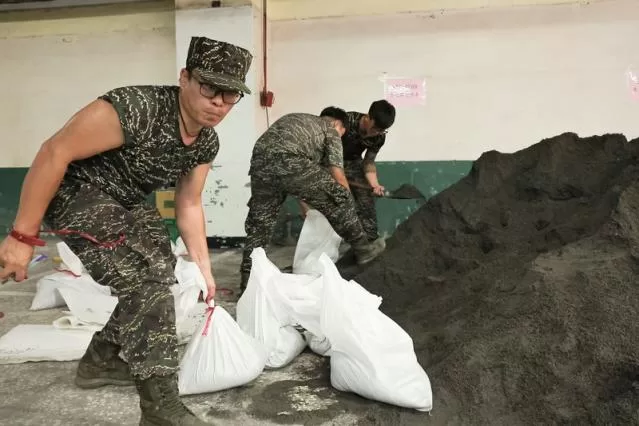Introduction: Taiwan Typhoon Preparations
As Typhoon Krathon approaches, Taiwan has initiated extensive measures to safeguard its citizens. The government has closed schools, offices, and financial markets, urging people to stay indoors in anticipation of the storm. This weather system, which has recently attained super typhoon status, previously wreaked havoc in the northern Philippines, resulting in flash floods and significant damage across the region.

Current Situation and Meteorological Overview
The Central Weather Administration (CWA) has issued warnings indicating that while the typhoon’s intensity has diminished, the threat from strong winds and storm surges persists. Coastal and low-lying areas remain particularly vulnerable, while mountainous regions are at a high risk of landslides and torrential rain. The storm is forecasted to make landfall between Kaohsiung and Tainan in the early hours of Thursday, prompting heightened vigilance across Taiwan.
Historical Context and Comparisons to Previous Typhoons
Taiwan frequently faces typhoons, yet it is uncommon for such storms to make landfall on the west coast. The last significant storm to impact this region was Typhoon Thelma in 1977, which resulted in 37 fatalities and widespread destruction. Chou Yi-tang, a government official in Kaohsiung, has urged residents to remain cautious, drawing comparisons between the current storm and past events. He recounted the devastation caused by Thelma, stating, “We were hit directly by the eyewall. Power was out for two weeks and no water for almost a month. It was disastrous.” This history has made many older residents particularly wary of Typhoon Krathon’s potential impact.
Precautionary Measures and Community Response
In anticipation of the storm, every county in Taiwan has declared a typhoon day, prompting widespread closures. This measure has received criticism in some northern regions, where city governments are accused of declaring days off to gain favor with voters. Yu Ren-yu, a 35-year-old sales representative, commented, “Because of Typhoon Gaemi being quite severe earlier this year, everyone is more cautious and prepared this time around.” Residents have stocked up on sandbags and supplies to bolster their defenses against potential flooding.
The impact of the storm has already begun to surface. More than 38,000 troops have been placed on standby to assist in emergency responses, while over 1,000 people have been evacuated from mountainous areas. Reports indicate 46 injuries have been reported, primarily in the eastern county of Taitung, where high winds and rain have caused chaos. Additionally, one person has been reported missing in Yunlin County.
Transportation Disruptions and Cargo Incidents
Significant disruptions to transportation have occurred, with over 200 international flights canceled and domestic ferry services suspended. Rail services have also been severely affected, with many lines reduced or temporarily halted.
In a concerning incident, a cargo vessel carrying over 67,000 tonnes of iron ore ran aground near Lanyu Island off the southeast coast. The ship, registered in Barbados, had 19 crew members on board, all of whom were rescued. However, there are fears of oil leaks from the vessel, prompting environmental concerns among local authorities.
The Impact of Previous Storms on Preparedness
The lessons learned from Typhoon Gaemi, which struck in July and led to 11 deaths and widespread flooding, are influencing current preparations. Kaohsiung authorities have distributed record numbers of sandbags to residents in anticipation of potential flooding. Government officials are emphasizing the importance of community readiness, urging residents to stay informed about the storm’s trajectory and to take necessary precautions.
Continuing Threat and Forecast
Despite Krathon’s weakening status, the CWA has indicated that its slow progression means the effects of strong winds and heavy rain will likely continue throughout the weekend. The ongoing threat is heightened by the storm’s erratic path, which could lead to unexpected changes in its intensity and impact. Authorities are carefully monitoring the situation, with updates provided regularly to ensure public safety.
Expert Opinions on Storm Preparedness
To gain further insights into the storm’s implications, we reached out to meteorologists and climate experts. Dr. Lin Chih-hao, a climate researcher at Taiwan National University, noted, “The frequency of severe typhoons hitting Taiwan has increased, which can be attributed to climate change. Communities need to adopt better preparedness strategies.” His opinion emphasizes the need for proactive measures to mitigate the impact of future storms.
Timeline of Events and Actions Taken
October 1, 2024: Typhoon Krathon strengthens to super typhoon status, bringing flash floods to the northern Philippines.
October 2, 2024: Schools, offices, and financial markets in Taiwan close. More than 200 flights are canceled.
October 2, 2024: Over 38,000 troops are placed on standby as emergency measures are enacted, and evacuations are conducted in vulnerable areas.
Conclusion
As Taiwan prepares for the potential impacts of Typhoon Krathon, collaboration between government agencies, military personnel, and the public is crucial. The lessons learned from previous storms and the expert opinions highlight the importance of preparedness in mitigating the effects of extreme weather events. By reflecting on past experiences and enhancing emergency response measures, Taiwan aims to navigate this challenging weather scenario while ensuring the safety and well-being of its citizens.
For Regular News and Updates Follow – Sentinel eGazette
FAQs:
- What precautions should residents take before a typhoon?
Residents should stock up on essentials, secure their homes, and stay informed about weather updates. - How does Typhoon Krathon compare to previous typhoons?
Typhoon Krathon has similarities to Typhoon Thelma, which caused significant damage in 1977. - What areas are most vulnerable during Typhoon Krathon?
Coastal and low-lying regions are particularly vulnerable, along with mountainous areas prone to landslides. - How can communities prepare for future storms?
Communities can prepare by developing emergency plans, conducting drills, and ensuring access to necessary resources. - What role does climate change play in typhoon intensity?
Climate change is believed to increase the frequency and intensity of severe typhoons due to warmer ocean temperatures.